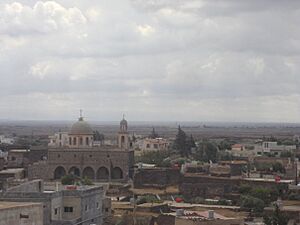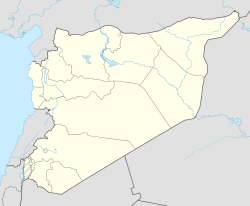Khabab facts for kids
Quick facts for kids
Khabab
خبب
|
|
|---|---|
|
Town
|
|

The old town of Khabab
|
|
| Country | |
| Governorate | Daraa |
| District | Al-Sanamayn |
| Subdistrict | Al-Sanamayn |
| Elevation | 700 m (2,300 ft) |
| Population
(2004 census)
|
|
| • Total | 3,379 |
| Time zone | UTC+2 (EET) |
| • Summer (DST) | UTC+3 (EEST) |
| Website | http://www.chabab.sy/ |
Khabab (Arabic: خبب) is a town in southern Syria. It is located in the Hauran plain, which is a flat area of land. Khabab is part of the Daraa Governorate. It is about 57 kilometers (36 miles) south of Damascus, the capital city. It is also about the same distance from the city of Daraa.
The old name for Khabab was Abiba. This name comes from the ancient Aramaic and Syriac languages. In these languages, Abiba means "a plain green grass."
Contents
History of Khabab
Khabab has a long history. In 1596, the town was recorded by the Ottoman Empire. At that time, it was known as Habab. It was part of a smaller area called Bani Kilab, within the Hauran Sanjak.
Back then, the town had both Muslim and Christian residents. They paid taxes on their crops and animals.
Who Lives in Khabab?
In 2004, a count showed that 3,379 people lived in Khabab. This number was recorded by the Syria Central Bureau of Statistics.
The number of people living in the town can change. In the summer, more people return for vacations. This makes the population inside the town grow to about 8,000 to 10,000 people.
Many people from Khabab live outside Syria. Around 40,000 people from Khabab are spread across the world. They live in places like France, the United States, Canada, Brazil, and Australia. Many also live in different Arab countries.
- The population grows by about 1.01% each year.
- About 51% of the population are females, and 49% are males.
Religions in Khabab
Most people in Khabab are Christians. Many of them belong to the Melkite Greek Catholic Church. The main church for this group is the cathedral of the Dormition.
Other churches in Khabab include Saint Rita and Saint Michael. There is also a place for nuns called the nunnery of the Besançon Charity Sisters.
Khabab's Climate
The weather in Khabab is similar to other parts of southern Syria. It has a moderate climate. This means it has cold winters and fairly hot summers.
Khabab clearly experiences all four seasons:
- Summer: The air is hot during the day, but the nights are pleasant with a dry breeze.
- Autumn: Leaves turn yellow, and the weather becomes cooler.
- Winter: It gets cold, especially in December, January, and February.
- Spring: This season begins in March.
On average, Khabab receives about 250 millimeters of rain each year (based on data up to 2000). Temperatures can range from -4 degrees Celsius in winter to 38 degrees Celsius in summer. The average winter temperature is 4.4 degrees Celsius, and the average summer temperature is 30 degrees Celsius.
Khabab's Economy
Historically, most people in Khabab were farmers. Farming was their main way to earn a living, just like in many other parts of southern Syria.
However, in recent years, fewer people rely only on farming. There are several reasons for this change:
- Rainfall: Farmers used to depend a lot on rain for their crops. The amount of rain affected how much food they could grow. Important rain-fed crops included wheat, barley, and lentils. Now, many farmers use irrigation to grow vegetables like tomatoes, watermelon, and carrots. Fruit trees like grapes, olives, and almonds are also important crops.
- New Jobs: Many residents now work in government jobs or for private companies. Their monthly salary has become their main source of income.
- Youth Migration: Many young people move to bigger cities, especially Damascus. Some also move to other countries in the Persian Gulf region, Europe, America, or Australia. The younger generation is often not as interested in farming as their parents and grandparents were.
- Other Work: Some people in Khabab have started working in business and industry.
Education and Culture
Khabab has a very high literacy rate, which means most people can read and write. This is because people in the town care a lot about education. Many talented individuals come from Khabab.
Schools run by the local church and monastery have played a big role. They have encouraged learning and science in Khabab and nearby villages.
There are seven schools in the town:
- One kindergarten for young children.
- Two basic education schools (primary schools).
- Four schools for middle and high school students.
Many people from Khabab are teachers or intellectuals. They work in villages and cities throughout the Daraa province.
Public Facilities
Khabab has many public facilities that help its residents. These include:
- A health clinic for medical care.
- A hospital that is currently being built.
- A police station to ensure safety.
- A public consumer shop for daily needs.
- A train station for transportation.
See also
 In Spanish: Jabab para niños
In Spanish: Jabab para niños


